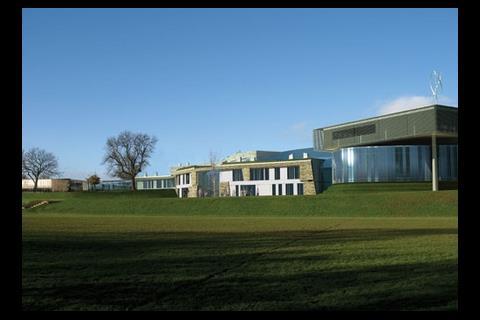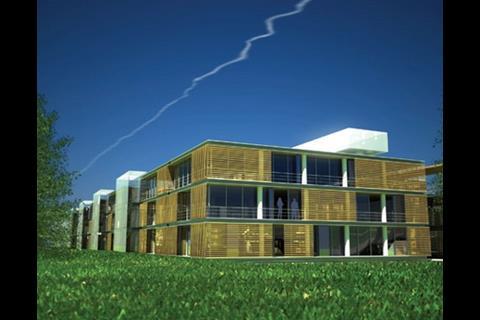Project teams have spent the past 12 months grappling with the new toughened-up version of part l of the building regulations. the result has been a lot of struggle, a lot of misunderstanding, and a lot of valuable experience … Martin Clowes of Elementa Consulting tells the story
It has been a year since Part L of the Building Regulations was introduced, but parts of the construction industry are still struggling to understand it. They are also having to get to grips with the requirements of Planning Policy Statement 22, which requires that at least 10% of a development’s energy requirements be generated onsite from renewable sources.
Both these requirements are having an impact on the way the industry works, as teams struggle to comply and hard-nosed clients struggle to keep keep costs down. These teams will not be comforted by the thought that even tougher energy regulation is on the way, and that each revision of Part L requires greater complexity of analysis, and the mandatory use of standard calculation software. This last requires a good understanding of building physics and engineering services. The next revision to regulations is scheduled for 2010 and is expected to be as significant as 2006’s.
In preparing this piece we talked to a range of practitioners - suppliers, architects, engineers, sustainability and building control specialists. All have found their work affected in a big way.
THE EFFECT OF 2006 PART L ON BUILDINGS
Part L1A: New-build dwellings.
The introduction of the 2005 SAP calculation methodology does not appear to have dramatically changed dwelling design. Window sizes have reduced somewhat and fabric insulation values have increased. And getting electrical heating and hot water systems to comply is regarded as difficult by many, so there are more gas boilers being installed. However, M&E engineers report that careful adjustment of the SAP input data can still produce a pass with electrically heated dwellings.
Part L1B - Refurbishment and extension of existing dwellings
Put simply, if you work on a controlled element such as a wall, a roof, or a floor, or a fitting such as a window, a door, or services, you need to consider upgrading it. The process is simple: you either add insulation to the elements or change fittings and services such as the glazing, doors or heating systems.
Problems arise over the details. Window and door frames can be heavy-looking, and you can forget about once-popular design details such as stripping off the plaster and sandblasting the brickwork. However, if the building is of genuine historic interest, attractive features can be retained without extra insulation.
Building control bodies will often allow elements to offset each other – in other words, by upgrading one element above the minimum requirement, another can perform less well.
Part L2A: New-build non-dwellings
The dust has not settled here. The energy and engineering design professions expected that L2A would lead to the end of 100% glazed, sealed, air-conditioned office blocks. They are still with us! The reason for this is that to comply, a building must achieve a performance that is a certain number of percentage points better than a similar 2002-compliant building. This means it is easier to get an air-conditioned building to comply than a naturally ventilated building, because there is less scope to improve the performance of a naturally ventilated building; it is already energy efficient.
Another problem is that the old and new regulations describe engineering systems in different ways, and the new software is not sufficiently flexible to allow for the wide variety of engineering systems available. So comparison between 2002 and 2006 results appears to be rather imprecise.
L2B: Existing non-domestic
This section of Part L must be the cause of more confusion and wasted time in design teams than any other. The problem is the detailed wording.
Part of it is straightforward. If you work on controlled elements, fittings or services, then you should upgrade them, provided that the costs of doing so meet the technical and economic criteria set out in Part L. However, many fabric upgrades do not fulfil the economic criteria and are unnecessary. But it does require a lot of work to justify whether the work is required, and only a few QSs appear to be tackling this. On most schemes there is little regulatory pressure for windows to be changed to double-glazing.
The most controversial part of L2B is proving to be the consequential improvements aspect to buildings larger than 1000m2. This is where an improvement to one element of the building triggers general improvements to another, subject to the technical and economic criteria. A number of organisations have produced flow charts to ease the pain, but unfortunately they are all different and some practitioners disagree on their correct interpretation.
Commercial fit-outs are another area of concern. A new building fitted out to category A standard has to fulfil Part L2A. But the subsequent tenant fit-out has to comply with part L2B, which could trigger consequential improvements. Taken literally, adding a new fan coil to an office that has had the partitioning changed could trigger consequential improvements, although this is plainly nonsensical. It seems like a good idea to retain the category A approved inspector for the subsequent fit-out to avoid conflicts of opinion.
The response to L2B by building control bodies is variable. The best of them find that teams tend not to be knowledgeable and like to engage in a lot of pre-consultation. However, some bodies are not fully up to speed and education and training is going to be needed for the foreseeable future.
Problems with SBEM
The “SBEM” referred to in the regulations has been the subject of extensive criticism in the media, largely because the software had to be developed quickly to meet the 2006 deadline. The “S” stands for simplified and it is really only suitable for the simplest of buildings. This has led to reports of cases where a revised version of SBEM has caused the same building to slip from a pass to a fail. This would have serious implications for the design and construction teams.
Initially, SBEM was only available from BRE; now it has been incorporated in other popular software tools to make calculating compliance easier for engineers. There are reports that different software packages appear to give different patterns of energy consumption. This may have a significant influence on the energy strategy adopted and the choice of engineering systems. We hear of firms offering to run the same building on different software systems to come up with the cheapest compliant solution.
Senior energy designers find outcomes from SBEM are sometimes counter-intuitive, yet there is nothing they can do as the national calculation methodology that underpins it is hidden. They would like access to its details but it is in the hands of the developers for the time being. Without understanding how SBEM arrives at results, seemingly unclear outcomes remain unexplained, making an industry consensus on best practice solutions more difficult.
In the right hands, best value outcomes can be developed with the available software. However, it is also possible to manipulate the calculation inputs to favour one set of building components or elements over another. So, the fabric can be downgraded, requiring a higher spec lighting or HVAC system. Or alternatively, the air-tightness can be set to a higher standard to reduce the need for other more costly measures.
This can lead to the burden of compliance being passed down the supply chain. For instance, the services engineer can cut the cost of the HVAC system by stipulating a very low infiltration rate, creating a nightmare for the architect and builder when it comes to compliance testing. Equally, some architects are still expecting services engineers to overcome poor envelope design and achieve compliance by the clever use software and services design.
For many, the outputs from SBEM are accepted on face value, but considerable knowledge of envelope and engineering services design is needed to get accurate outcomes.
It is vital for the team and building control to manage the software development, input parameters and implied construction details right through the project. This has an impact on many trades. For example, changing a glazing spec could require a change of the HVAC system or the lighting concept. This has a big impact on the way contractors commonly work. Late changes of supplier are possible but the carbon impact must be assessed and the requirements transferred to the trade supplier.
DESIGN RESPONSES TO PART L
Teams are developing a new way of working. Uncomfortable as it may seem to many clients and architects, energy and sustainability advisers are being brought in at the front-end of projects. The M&E engineer, once the Cinderella of the
industry, is now in demand even on modest-sized projects. At a time of skills shortages, this is a challenge.
Specialist sustainability and energy consultants are sprouting up everywhere you look. Until last year, there were only a few hundred people active in UK practice and therefore, recognised as being reasonably competent.
As usual, when faced with a complex problem, people are searching for a magic bullet. Ground-source “heat pump boilers” biomass heating and CHP are being widely considered. Advanced construction methods such as Termodek are being considered on ever smaller schemes, and the methods themselves are being developed to stay ahead of the game as manufacturers rush to prove their renewable and low-carbon credentials.
Team responsibilities: a crunch
The complexity of the energy regulations is causing difficulties for many teams. Clear “ownership” of design and construction from inception to hand over is rarely allocated to a single party. Demarcation errors or failure to properly carry out the calculations and then inform all the relevant trade contractors are causing problems. We hear rumours that some buildings have had to replace elements as critical as windows in order to achieve compliance.
M&E trade contractors are becoming very concerned that their responsibilities are impossible to discharge unless they have clear instructions regarding the energy performance required from the kit they purchase. There are significant risks and the consequences in liability are as yet not fully known, because few buildings have gone through the full process.
Where clients do not pay for the work in advance, contractors may find the risks unacceptable. Certainly we can expect to see the cost of bidding rise if the risk is to be effectively managed.
The perceived solution so far has been to bring in energy advisers before planning applications are made. This helps, but the detailed work to achieve compliance reliably has to follow through the whole construction process. The following is a guide to the people getting involved in the energy design and process management at different stages, which includes new specialisms:
- RIBA Stage C: energy/sustainability consultant
- RIBA Stage D: M&E designer/energy consultant and building control body
- Design-and-build bid: contractor and M&E designer/energy consultant and building control body
- Construction, M&E aspects: M&E contractor
- Fabric: contractor, compliance specialists or M&E consultant
- Hand over: contractor/compliance specialists and building control body
On completion, the building control officers must decide whether a building passes or fails based on the evidence before them. In view of the number of parties and the potential responsibilities this task must be difficult to get right.
Summary
So, is new Part L working? Well, yes, to a degree, although the low carbon hopes of many have had to be tempered for the time being.
The jury is out as to whether the 19-28% reduction on 2002 standards will be achieved. The regulations will certainly result in better buildings than those of 2002, if only through increased energy awareness and the greater amount of design thought that must now go into them. Also, the improved air-tightness testing regime and the final compliance checklist will definitely deliver results. But until we get serious about energy rating certificates and measuring actual post-occupancy energy use, we will probably never really know. But that story is still to be told.
AIR-TIGHTNESS TESTING: SCIENCE OR DARK ART?
The air-tightness of the building envelope is a big factor in the SBEM calculation and the latest Part L allows designers to set the standard as part of their suite of energy reduction measures. The minimum performance is an air infiltration rate of 10m3/hr/m2. We know that some designers are setting lower figures to make the services design easier and to improve BREEAM ratings. The quality of compliance is an issue for teams to consider more carefully. There are rumours of buildings being excessively leaky, but this is being ignored.
We spoke to David Pickavance of independent tester BSRIA to see how this little-understood activity is settling in.
Why is air-tightness important?
“A significant proportion of energy losses in buildings, historically between 40% and 60%, is attributable to ‘unintentional’ air leakage. Examples include porous materials, blockwork and cladding systems, discontinuity of seals owing to badly detailed or badly constructed interfaces between systems, or where two trades meet and responsibility for making the seal has not been allocated.
“Trouble arises from mistakes made in design, specification, procurement or construction. It’s not just the energy losses that are important. If there is excessive air leakage, the designed heating, cooling and ventilation systems will not be able to control the environment, leading to uneven temperature within the building and discomfort to the occupants. In buildings such as hospitals, for example, this could be as serious as not being able to control the air quality in critical areas such as operating theatres, or isolation units. So, it is important.
“We have one client who has a large number of buildings and among them we have found two of the same specification and similar build quality in the same environmental conditions - one had air permeability of 8m3/hr/m2 and the other
4m3/hr/m2. After studying the energy bills for a year, we found that the one with 4 used 35% less gas for heating. This is a fairly direct measure of CO2 performance!
“Also, we see targets as low as 2 or 3m3/hr/m2, which is pretty hard to achieve, and impossible if you don’t manage it properly.”
Who can do the testing?
“All non-dwellings with a gross internal floor area greater than 500m2, and a percentage of each type of dwelling on a large development must be tested. There is ample testing capacity in the market, and testers can issue test certificates that are ‘deemed to satisfy’ the requirements of Building Control. It is expected that contractors will gradually stop risking the use of non-registered testers, as building control stops accepting results from them.”
What are the challenges?
“Architects need to consider air-tightness-related detailing and systems in their concepts and designs. Get the subject on the design agenda early on. Specifiers need to consider the use of systems and materials with known air-tightness performance. Contractors need to assign responsibilities for sealing at every stage of the construction process, inspect interfaces and learn from previous successes and failures.”
How are buildings currently performing?
“Sheds are generally performing well and we at BSRIA see about 85% of sheds passing at the 10 level, whereas only about 50% of office-type buildings pass. Schools seem to be performing poorly with about 80% failing first time.“
What next?
“In the future there will be more downward pressure on the requirements as SBEM-type tools are used and clients require better ratings under BREEAM, EcoHomes and so on.”
Regulations April 2007

A guide to environmental regulations in the 21st Century
- 1
- 2
- 3
 Currently
reading
Currently
reading
Part L, one year on
- 5
- 6
- 7
- 8
- 9
- 10
- 11
- 12

















































No comments yet